Publications
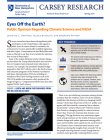
June 13, 2017
Survey researchers have observed significant political divisions in the United States with regard to public trust of science related to evolution, the environment, vaccines, genetically modified organisms, and other topics. Conservatives are less likely than moderates or liberals to say they trust scientists for information on any of these topics.1 Some of the widest divisions involve climate…
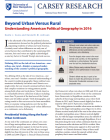
June 27, 2017
In the aftermath of the 2016 presidential election, commentators focused on the political polarization separating residents of urban and rural America. Certainly rural–urban differences are only one of several factors that contributed to the surprising 2016 outcome, but rural voters are rightly acknowledged as one key factor in Donald Trump’s electoral success. Yet, defining 2016 as the tale of…
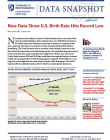
June 30, 2017
New data from the National Center for Health Statistics show a record low birth rate in the United States. In 2016, I estimate there were 600,000 fewer births in the United States than would have been expected had pre-recessionary birth rates continued. And, there is no evidence in these new data that this birth dearth is diminishing.
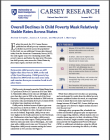
September 15, 2016
Earlier this week, the U.S. Census Bureau published its official poverty estimates noting a decline in poverty across the population.1 In this brief, we use additional Census data released today from the American Community Survey (ACS), the only regular source for estimating yearly child poverty rates at, and below, the state level. We examine child poverty rates across the United States by place…
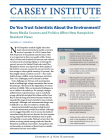
May 20, 2014
In this brief, author Lawrence Hamilton examines the results of a Granite State Poll conducted by the University of New Hampshire Survey Center in late January–early February 2014. The poll asked about public trust in scientists, along with other questions on science, political, and social issues that help to place the science-trust results in perspective.

June 3, 2014
This brief uses data from the 2013 Annual Social and Economic Supplement to the Current Population Survey to examine how President Obama’s proposed expanded eligibility and higher credit values might affect tax filers in both rural and urban America.
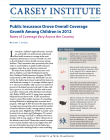
June 17, 2014
Using data from the American Community Survey, this brief examines the rates of health insurance coverage among children under 18 in the United States by region and by rural, suburban, and central city residence between 2008 and 2012.

July 15, 2014
This brief identifies gaps in support services among foster parents using data from a nationally representative survey of children involved in the child welfare system (the second National Survey of Child and Adolescent Well-Being).
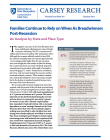
July 29, 2014
This brief presents an analysis of the increased role employed wives played in family economic stability prior to, during, and after the Great Recession, focusing on changes in the contribution of employed wives’ earnings to family earnings by state, region, metropolitan areas, and nonmetro residence.
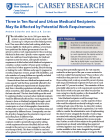
July 6, 2017
The Affordable Care Act in 2010 gave states the option to expand Medicaid access to adults with incomes up to 138 percent of the federal poverty level. Thus more able-bodied and working adults have become eligible for Medicaid. In addition, several states have petitioned the federal government to have the option to enforce work requirements for those receiving Medicaid in their state.1 Specific…
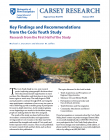
September 3, 2014
In this brief, authors Michael Staunton and Eleanor Jaffee review the key findings and recommendations from research conducted in the first half of the Coös Youth Study, which began in 2008 and is planned to continue through 2018.
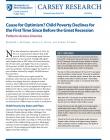
September 19, 2014
New data released on September 18, 2014, by the U.S. Census Bureau indicate that child poverty fell by 0.4 percentage point between 2012 and 2013, to 22.2 percent. Though still significantly higher than in 2007 when the Great Recession hit (18.0 percent), and higher than at its conclusion (20.0 percent) in 2009, the decline from 2012 may be cause for optimism. Estimates suggest the number of poor…
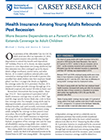
October 21, 2014
While much of the existing research explores young adults' insurance only in the post-recession period (that is, 2010 to present), authors Michael Staley and Jessica Carson assess young adults' rates of coverage within and beyond the context of the recession by examining changes across the entire 2007 to 2012 period.

October 28, 2014
In 2013, Carsey released a brief that analyzed rates of restraint and seclusion using a large, nationally representative data set of U.S. school districts. This brief, which analyzes a more comprehensive data set and the most current Civil Rights Data Collection, serves as a follow-up to the previous brief.
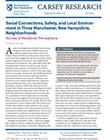
November 12, 2014
This fact sheet uses data from a survey of Bakersville, Beech Street, and Gossler Park residents in Manchester, New Hampshire, to draw attention to the current state of connectedness, trust, and perceptions of the local environment in these three neighborhoods.
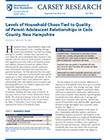
December 2, 2014
In this brief, author Corinna Tucker examines Coös County adolescents’ reports of household chaos using data from the Coös Youth Study and discusses whether socio-economic and parenting differences are related to adolescents who experience household chaos.
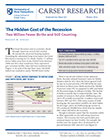
December 5, 2014
The Great Recession sent an economic shock through American society that reached far beyond the stock and housing markets, including the substantial long-term impact the Great Recession is having on U.S. births. Nearly 2.3 million fewer babies were born in the United States between 2008 and 2013 than would have been expected if pre-recession fertility rates had been sustained (see Figure 1). In…
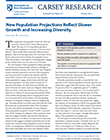
December 10, 2014
Two important demographic trends are reflected in newly released Census Bureau projections. The pace of U.S. population growth is slowing, and the population continues to become more diverse. These trends reflect distinctly different demographic trajectories among whites and minorities driven by the interaction of several key demographic forces. This will produce a rich tapestry of demographic…

December 16, 2014
In this report, author Cynthia Needles Fletcher explores the role of "place" in shaping rural residents'-and in particular low-income residents'-futures. The analysis draws from interviews with residents and community key informants in Hampton, Iowa in an original study in 1997 and again in 2012-13.
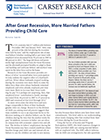
February 3, 2015
The U.S. economy lost 8.7 million jobs between December 2007 and January 2010.1 Sixty-nine percent of the jobs lost during the recession were held by men, 2 and the employment rate of married fathers (whether working full or part time) with employed wives decreased from 92 percent in 2005 to 88 percent in 2011.3 The large job losses and persistently high unemployment from the Great Recession and…
